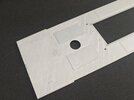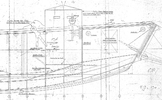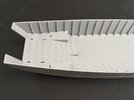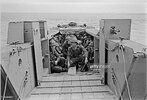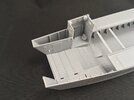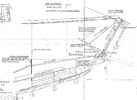Early on 1 November 1944, the LCA fleet left Breskens harbour for Vlissingen, about 5 km away across the West Scheldt. In all, they were carrying some 555 troops: the actual assault force was 400 men (6 troops) from No. 4 (Army) Commando, augmented by a dozen men from the Dutch troop of No. 10 (Inter-Allied) Commando to act as local liaison and interpreters, as well as engineers, pioneers and others plus about 40 men from the Royal Navy beyond the landing craft crews.
This is what Vlissingen was like ca. 1944:
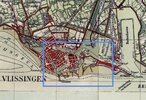
Well, actually, this is a map from 1925, but there doesn’t seem to be a more recent one. In any case, the outer parts of the town were inundated, but the old town was still mostly dry. However, Vlissingen has some claim to being the most-bombed town or city in the Netherlands during the entire war, due to its important port and shipyard, which, as you can see, were right in the heart of the town.
The blue rectangle on the map indicates the area covered by this one:
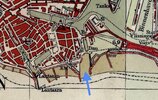
And here, the arrow is the landing zone. Officially, this was the
Oosterhaven (“Eastern Harbour”) or
Dokhaven (“Dock Harbour”, referring to the dock beyond it) but it was commonly known as
’t Slikhaventje, literally “the Little Mud(dy) Harbour”. The British had given it the codename of “Uncle Beach”; the rest of Vlissingen had been divided into sectors that had also been assigned codenames. Those codenames are often used in accounts of the fighting, but are hard to relate to modern locations; unfortunately, I couldn’t find a map online just now that does that.
BTW,
here is the source of these maps — you can scroll through the timeline on the left to see how the city (or other parts of the Netherlands) change over time. You can also directly compare two time periods by clicking on
Vergelijken at the top left and using the timelines on both sides of the screen to show maps from different years.
Here’s what all of that looked like from the water:

(
source)
Remember I said there was a shipyard?

Or, if you would like to see the military situation on 28 October 1944:
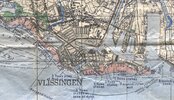
(This is a scan from an original British map owned by my father, which my grandfather took out of one of the tanks left behind at Westkapelle.)
Uncle Beach is where it says “5 Rows stakes” near the bottom. Each of the arrows is a machine gun, an arrow coming from a square box is a machine gun in a pillbox.
Today, this whole area has changed quite a lot, mainly because the sea defences have been strengthened, especially in the 1980s–90s. It now looks like this:
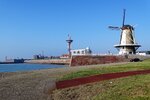
Its official name since a number of years is
Uncle Beach, as you can see on the wall in the background, though you can’t really find the old harbour in the landscape anymore. Nearby is the Commando Memorial:
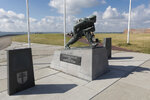
But back to 1 November 1944 … A small reconnaissance unit known as Keepforce, after its commander, Royal Navy Captain R.W. Keep, was first ashore in order to guide the actual assault force in. First to land was part of No. 1 Troop of 4 Commando, coming from an LCA at approximately 05:45 hours to establish a bridgehead. They cut barbed wire and clear other obstacles for the following troops, and soon, the next five LCAs come in — but by now the Germans are alert and open fire. However, their aim is too high and nobody is hit.
Meanwhile, the Navy’s Beach Signal Party is trying to set up its gear, but finds that the radio isn’t working. The spare radio, carried for just this happening, is unfortunately in a second LCA that got hit and sank … A third set from yet another LCA is finally brought ashore in working order — but that’s not the end of the problems, because the supplies they need, including generators for the radios, are carried in LCAs that hit underwater obstacles and begin to flood, making the equipment unusable. It will take until later in the day for fresh batteries to be brought in from Breskens.
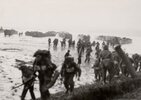
By 06:10, two full Commando troops are ashore and begin pushing into the town. Within an hour and a half, there are some 550 men ashore from 22 LCAs. They not only reinforce the attack into the town but also help clear the beach for the follow-on troops from 155 Infantry Brigade, mainly the 5th Battalion of the King’s Own Scottish Borderers. These are also mostly ferried across in LCAs, but 20 LVTs (Buffalos) are also used to carry materials and troops from Breskens to Vlissingen, as well as taking casualties back the other way.
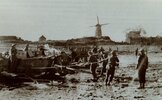
Not just wounded soldiers, but also civilians:
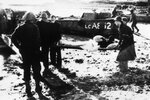
The men carrying the stretcher are locals. The rear one is wearing a pre-war Dutch Army helmet, the front one seems to have a fireman’s helmet (going by the neck flap).
All this, of course, under German fire — not just machine guns but artillery and initially even a 20 mm Flakvierling 38, though that soon got overrun by the Commandos who rapidly turned it the other way and put it to use against its former owners.
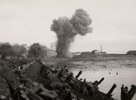
Here’s an interesting photo of LCAs lying on the beach at what looks like low tide, while an LVT carrying an M29C Weasel in its hold, makes its way towards the town:
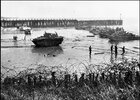
And a look the other way, from the opposite side of the harbour towards the windmill:
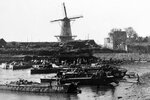
Later on, German prisoners were collected in the area, waiting transportation to the other side:
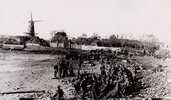
After the war, some LCA wrecks remained for some time:
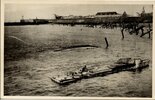


















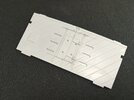
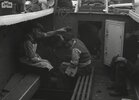
 .
. .
.